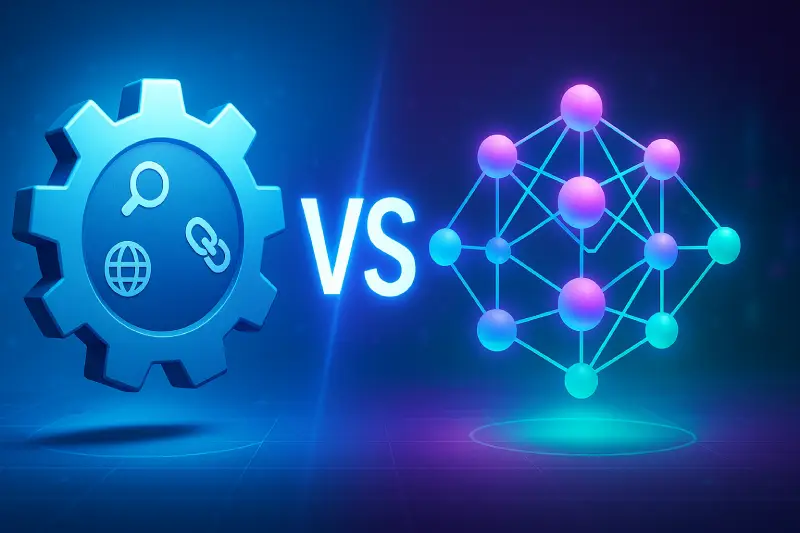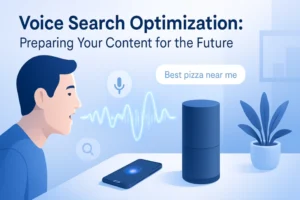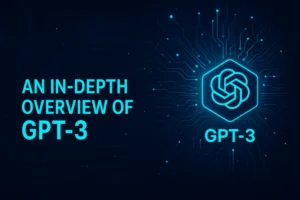Years ago, dominating Google was the key to gaining visibility online. Appearing at the top of search results would bring a steady stream of people looking for what you have to offer. For nearly 20 years, SEO has been the go-to method for businesses and organizations to increase their online visibility.
However, a different player is starting to challenge that supremacy. Something smarter. Faster. More conversational. GEO has entered the scene.
Think ChatGPT, Google Gemini, Claude. These aren’t traditional search engines. They don’t list 10 blue links. They generate answers. They reference sources. They decide which websites they will use as sources or leave out. GEO focuses on guiding this decision-making.
This is important because of changes in how users search for information online. Because user behavior is shifting. More and more users are relying on AI chatbots instead of searching directly on the web. Being absent from these responses can make your content less visible to a significant chunk of the web.
In this blog, we’ll break down SEO vs GEO in plain English. We will discuss the distinctions between them, ways to optimize for both and the implications for your content strategy moving forward.
What Is SEO? (Search Engine Optimization)
SEO is the practice of optimizing your website to increase visibility and appear in search results when users look for related topics. Imagine your website like a digital billboard on a major highway, but only if you follow the guidelines set by search engine algorithms.
Search engines scour the internet to identify every website on the web. Search engines rank pages according to their importance, how well they respond to users’ queries and how well they are organized. Search engines show the most relevant pages when someone types a search query.
We can break this down into essential elements.
How SEO Works
- Keywords: Optimizing content with the search keywords people are actually searching for. Ex: How to find the best pizza deals online? What are some effective techniques to speed up WordPress?
- On-Page Optimization: Using title tags, meta descriptions, heading tags and internal links to make your site easier for search engines to crawl and index your content.
- Technical SEO: Making the site lightning-fast, mobile friendly, easily accessible by search engines and secure with HTTPS.
- Backlinks: Authority boost and trustworthiness come from other sites linking to yours.
- Content Quality: Google values content that benefits people by showcasing authority and trustworthiness (EEAT).
Strengths of SEO
- Sustainable Organic Traffic: Ranking allows you to receive traffic from search engines organically.
- High Intent Audience: People who search for your products or services typically have clear intentions.
- Brand Authority: Ranking high shows searchers you can be relied on.
Limitations of SEO
- Takes Time: Building new pages may require several weeks or months before they show up in search results.
- Highly Competitive: Competition for the highest positions is frequently won by major corporations or content mills.
- Algorithm Dependence: A single algorithm change can cause your rankings to significantly change in a short period.
- Doesn’t Serve All Queries: For certain questions, people now turn directly to AI for responses instead of using Google.
What Is GEO? (Generative Engine Optimization)
GEO, or Generative Engine Optimization, is the emerging practice of optimizing your content to show up inside AI-generated responses from tools like ChatGPT, Google Gemini, and Claude. These tools don’t display a list of links. They summarize, reword, and synthesize—then quietly cite select sources.
In GEO, the game changes: You’re not just trying to rank—you’re trying to be referenced.
While traditional SEO targets how a webpage appears on a search results page, GEO focuses on how a piece of content gets recognized and reused by generative AI models when users ask questions, give prompts, or request summaries.
Key Components of GEO
- Citation-Worthy Content
Write fact-based, clear, quotable, and structured material. AI tools are trained on high-quality sources—they love data, clean formatting, and crisp claims. - Entity Optimization
Mention your brand, authors, product names, and relevant facts consistently across the web. Language models use this info to assess credibility. - Factual Authority & EEAT Signals
AI systems prioritize reliable sources. Pages that include references, expert insights, and clear context tend to get “picked up” more. - Prompt Compatibility
Think beyond search queries. Optimize for how users ask ChatGPT or Bard: e.g., “What is the difference between SEO and GEO?”
Answer that exact question clearly in your content.
Tools & Metrics for GEO
- AI Answer Tracking Tools (e.g., SEO.ai’s GEO tracker, AlsoAsked for prompt trends)
- Monitoring ChatGPT/Bard Citations
Manually check if your site is being referenced by giving prompts to AI models - Brand Mentions in AI Responses
Unlike backlinks, you’re watching for inclusion in generated answers—even without a clickable link
GEO is still evolving. But ignoring it now is like ignoring SEO in 2005. The earlier you adapt, the better your odds of being visible in an AI-first internet.
SEO vs GEO – A Direct Comparison
On the surface, SEO and GEO might sound like two sides of the same coin—but they’re playing entirely different games. While SEO helps you rank on Google’s result pages, GEO helps you get quoted in AI-generated answers. One optimizes for clicks, the other for mentions inside content that users may never even leave the AI to read.
Let’s break this down:
Comparison Table – SEO vs GEO
| Feature | SEO (Search Engine Optimization) | GEO (Generative Engine Optimization) |
|---|---|---|
| Target Platform | Google, Bing, Yahoo | ChatGPT, Bard, Gemini, Claude |
| Ranking Goal | Appear in top 10 search results | Be cited or referenced in AI-generated answers |
| User Intent | Search queries with clear keywords | Natural prompts or questions to AI tools |
| Optimization Style | Keyword usage, metadata, on-page SEO | Clear structure, authoritative tone, factual accuracy |
| Citation Signal | Backlinks from other websites | Brand mentions, fact-based content |
| Time to Visibility | Weeks to months | Sometimes immediate (once indexed by LLM) |
| Content Format | Blogs, guides, landing pages | Data-rich, source-friendly answers and FAQs |
| Tools Used | Ahrefs, SEMrush, Yoast, Google Search Console | SEO.ai, Prompt tracking tools, LLM feedback |
| Best For | Organic website traffic | AI presence, branding, early mover advantage |
Key Differences in Content Structure
- SEO content focuses on keyword placement, internal links, and formatting for bots.
- GEO content leans heavily on clarity, citations, clean markup (like FAQs), and data points that AI can lift directly.
Visual Analogy – SEO vs GEO
Think of SEO as writing for a librarian (Google) to catalog your book on a shelf.
Think of GEO as writing for a robot professor (ChatGPT) who might quote your work in a lecture.
Can SEO and GEO Work Together?
Absolutely—and they should. SEO and GEO aren’t rivals. They’re two parallel engines driving your content visibility across two very different digital highways.
While SEO gets your site ranked on traditional search engines, GEO boosts your brand’s presence inside AI-generated responses. You don’t have to choose one over the other—the real advantage lies in combining both strategies.
Why SEO and GEO Are Complementary
- SEO drives clicks, bringing traffic to your website through search rankings.
- GEO drives mentions, enhancing brand recognition and topical authority inside AI answers.
- A user might search a term on Google, visit your site, then later ask ChatGPT—and remember your brand if you’re mentioned there, too.
How to Blend Both in a Single Strategy
- Write for humans first, optimize for both engines. Ensure your content is clear, concise, and useful.
- Use structured data (schema markup) to help both Google bots and AI engines understand context.
- Include FAQs or Q&A blocks. These are loved by both SERPs and AI bots for direct responses.
- Maintain accuracy and cite original sources. It boosts your GEO score and supports EEAT for SEO.
- Use headings logically. AI models rely on them to extract key ideas, while search engines use them for crawlability.
Real-World Example
Let’s say you run a blog about digital marketing.
- Your SEO-focused blog ranks on Google for “What is email marketing?”
- That same article, thanks to clear explanations and a few referenced stats, gets quoted by ChatGPT when someone asks, “How does email marketing work?”
Now, you’re visible in both worlds—the search-driven world and the AI-powered one.
How To Optimize for GEO (With SEO Basics in Place)
If you already know how to optimize for SEO, you’re halfway there. But GEO demands a slight mindset shift—less about ranking pages, more about crafting content that AI models want to cite.
You’re not writing for a list of links. You’re writing for machines that summarize, paraphrase, and quote. Here’s how to future-proof your content for Generative Engine Optimization:
1. Create Factual, Citable Content
- Include stats, data, definitions, and original insights
- Clearly attribute external sources when referencing
- Use short, quotable sentences—ideal for AI to lift and include
Example: Instead of writing “There are many tools that help,” say “SEO.ai and AlsoAsked are popular tools for tracking AI citations.”
2. Format Like an AI Would Think
- Use bullet points, tables, and clear subheadings
- Answer common questions directly (e.g., “What is GEO?” in or FAQ format)
- Keep sections tightly scoped—AI models prefer modular chunks of knowledge
3. Use Schema Markup Wherever Possible
- Apply FAQ schema, Article schema, HowTo, or Q&A formats
- Helps both Google and AI understand your page’s structure
- Increases chance of appearing as a source or featured snippet
4. Be Consistent Across the Web
- Ensure your brand name, author bio, and publishing history align across platforms
- AI models reward consistent entities—it builds perceived authority and trustworthiness
5. Optimize for Prompt-Like Queries
- AI users ask in full sentences, not just keywords
- Include natural questions your audience might enter into ChatGPT or Gemini Ex: “What’s the difference between SEO and GEO?” or “Which is better for ranking—SEO or GEO?”
6. Monitor Your GEO Impact
- Use tools like SEO.ai or manually test prompts in AI tools
- Track branded mentions and paraphrased versions of your content in AI responses
- Repurpose what works—double down on pages being cited
GEO isn’t about manipulating an algorithm—it’s about being the most helpful, factual, and cleanly formatted source in a sea of AI noise. Combine that with solid SEO principles, and your content won’t just rank—it’ll echo.
What the Future Holds – Is GEO Replacing SEO?
This is the burning question. With tools like ChatGPT, Bard, and Gemini now answering questions instead of pointing to links, does this mean the end of SEO?
Short answer: No—but it’s evolving fast.
SEO isn’t dying—it’s shifting. GEO isn’t a replacement; it’s an expansion. As user habits change, your content needs to live in both environments: the clickable web and the conversational interface.
The Rise of AI Search Experiences
- Google’s Search Generative Experience (SGE) now blends AI answers with classic results
- Microsoft’s Copilot shows ChatGPT-style answers before listing Bing results
- This trend is spreading across platforms—Reddit, YouTube, and even Amazon are testing generative layers
If your content isn’t AI-friendly, you risk being skipped—even if you’re ranked.
What Might Change for Content Creators
- Shift from keyword stuffing to clear explanation
- Less focus on ranking 1st—more focus on being referenced
- Greater demand for structured, fact-checked writing
- Rise of entity-based optimization (Google and AI models use “who” more than “what”)
What Will Always Matter
- Human value. AI rewards content that solves real problems
- Brand authority. A known source is more likely to be quoted
- Clarity. Simple, well-structured content always wins—whether it’s a bot or a human reading
Conclusion of This Section
GEO is not a trend—it’s a tectonic shift. But just like mobile-first or HTTPS did with traditional SEO, those who adapt early will own more digital real estate than those who ignore the signs.
Final Thoughts – Adapt Now or Risk Irrelevance
Whether you’re a blogger, a business owner, or a content strategist—here’s the truth:
The way people find information is changing, and your content needs to evolve with it.
Traditional SEO still matters, but it’s no longer enough. Generative AI engines are shaping how users consume answers, and if your site isn’t AI-ready, you’re invisible where it counts.
You don’t need to ditch everything you know about SEO. What you need is to layer in GEO—strategically, deliberately, and with an eye toward the future.
Actionable Takeaways to Win in Both SEO + GEO
✅ Continue building quality backlinks and targeting keywords — they still matter
✅ Rework top content into structured, citable blocks for AI engines
✅ Add FAQ and How-To schema wherever applicable
✅ Include statistics, short definitions, and clearly attributed facts
✅ Track whether your content is being picked up by AI-generated answers
✅ Think like a human, write like an expert, structure like a machine
Quote to Leave Readers Thinking
“In the past, we optimized for bots to get clicks. Today, we optimize for brains—both human and artificial—to be remembered.”
FAQs about SEO vs GEO
Is GEO the end of traditional SEO?
No. GEO is not replacing SEO—it’s expanding the playing field. SEO remains crucial for driving search traffic from Google and Bing. GEO complements it by making sure your content is cited in AI-generated answers from tools like ChatGPT and Gemini.
Can I rank in both Google and AI chat tools?
Yes. With the right strategy, your content can rank in Google and be referenced in AI models. The key is creating content that’s both keyword-optimized and structured in a way that makes it easy for AI to understand, summarize, and quote.
What kind of content does ChatGPT or Gemini cite most often?
AI models tend to cite content that is:
- Clear and fact-based
- Well-structured (e.g., with bullet points, tables, or headings)
- From sources that are consistent and authoritative
- Free from fluff or overly promotional language
Do backlinks help with GEO too?
Indirectly, yes. While AI tools may not follow backlinks the way search engines do, backlinks still build brand authority, which increases the chances of your site being seen as trustworthy by LLMs. Consistent references across the web also help AI models “learn” your site’s reliability.
How can I track if my content is being cited by AI tools?
Currently, there are no universal dashboards for GEO tracking, but you can:
- Test prompts manually in ChatGPT, Bard, and Claude
- Use SEO.ai and similar tools that monitor generative responses
- Check Google SGE (Search Generative Experience) if available
- Track brand mentions in analytics platforms and AI-augmented search interfaces




